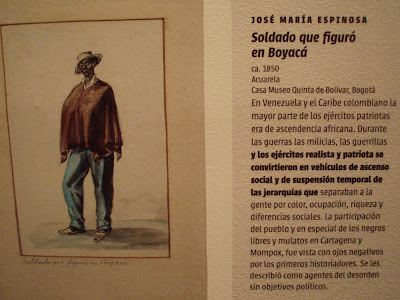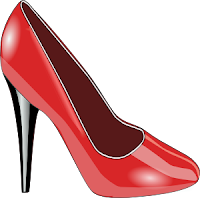One Family's Return Trip: Afrocolombian Hero
http://raisingcolombiankids.blogspot.com/2009/08/anniversary-of-law-70-celebrating-16.html
Since today is the anniversary of the passing of this law, I thought I'd share what we learned yesterday at the Museo Nacional about the role of Afrocolombians in Colombian Independence.

Here is a translation: In Venezuela and the Colombian Caribbean region, the majority of the patriot army was of African descent. During the wars, the militias, the guerrillas, and the armies (both royalist and patriot) became vehicles for social climbing and the temporary suspension of hierarchies that separated the people by their race, occupations, affluence and social differences. The participation of the people, and particularly the free blacks and mulattoes (mixed race) peoples in Cartagena and Mompox, was initially seen by historians as a negative. They were described as agents of disorder without political objectives. This is a picture of the Afrocolombian soldier José María Espinoza. He participated in the Battle of Boyacá.
But, perhaps the greatest discovery I made, and I have to say even my Colombian husband didn't know this, was that the hero of the Battle of Pantano de Vargas, Juan José Rondón, was the son of African slaves! Here is his story:
One of the great heroes of Colombian Independence wasn't actually born in Colombia. He was, in reality, born in Venezuela in 1790. In 1812, he joined the Spanish Royal army there. However, when he saw the unnecessary cruelty of the Spanish, he became disillusioned. He joined a force of about 50 rebels, and with this act became an outlaw of the state.
In time, his group (men on horseback experienced with the use of lances) became part of the liberating army.
At the Battle of Pantano de Vargas, Bolivar's troops were losing. From his vantage point on a hill, Bolivar lamented that after 7 hours of battle, his troops were tired and unable to gain ground. Suddenly, the Spanish General Barreiro, sent the last of his troops and his cavalry to attack the liberating army. Bolivar proclaimed, "They have sent the cavalry, all is lost!" Rondón responded, "Why do you say that, my General, if Rondón and his Llaneros haven't even fought yet?" Bolívar turned to the man and responded, "Coronel Rondón, salve usted la patriá! (you go save the country!)" Yelling, Rondón cried, "Let the courageous follow me!" Fourteen llaneros with their lances followed him. Rondón and his small band turned the tide of the battle.
This is one of the most famous stories of Colombian Independence. There probably isn't a Colombian that hasn't heard that line, "Salve ud. la patria!", dozens of times. It is a sentinel moment in Colombian history.
I wanted to point out, that portraits of Rondón have him pictured from white to brownish to black. The most commonly seen picture of Rondón is not the one where he is actually black, like the son of slaves would have been. Here is a link to google pictures for Rondón. You can see the different versions for yourself. http://www.google.com/images?q=juan+jose+rondon&rls=com.microsoft:en-us&oe=UTF-8&startIndex=&startPage=1&rlz=1I7ADSA_en&um=1&ie=UTF-8&source=univ&ei=MKdyTMz0BYigsQO4pKzLCg&sa=X&oi=image_result_group&ct=title&resnum=4&ved=0CDoQsAQwAw

Comments